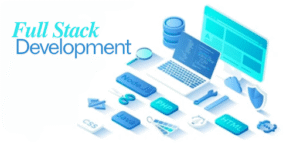In the emerging realm of information sharing through written articles, the blog has turned out to be one of the most valuable assets of the internet. When you are full stack developer you can create your blog from the ground up, which will contain both front and backend. Full stack development concerns client and server technologies where the developers can design, develop and deploy end Web applications. This blog will demonstrate the essential features and provide an overarching overview of the technologies associated with, building a blog through full stack development.
What Does Full Stack Development Mean?
Full or end-to-end development involves using frontend tools such as HTML, CSS, JS, and tools such as Node, Express, or even databases like MongoDB or MySQL. Developers can rely on these tools to create the entire application layout and control it simultaneously to accommodate the interaction with a server. Employing these skills with the help of the Full Stack Developer Course in Chennai can pave the way for a successful career where you design functional, good-looking applications like a blog.
Guidelines on How to Develop a Blog using Full Stack
Development
1. Set Up Your Development Environment
The first step is to create a development environment. For most full-stack projects, when developing locally, you need Node.js and a code editor, such as Visual Studio Code. Make all the needed installations and dependencies using typical modern technologies, such as React for theutilizend part and Express for the backend part.
2. Design the Blog Interface (Frontend)
Your blog should not only be attractive, but the layout and design should also be easy to navigate. Begin with HTML and CSS to set up your layout and design your pages. When you are working with a JavaScript framework, you have classes to act as post, form, and navigation controls. Bootstrap can be used, which provides a responsive design to the application, so it will be easily adaptable to mobile and desktop views.
Key sections to include:
- Homepage: Show a list of blog posts with summaries and links to full articles.
- Post Page: Display individual posts, including titles, content, and dates.
- Create/Edit Post: Develop a form for writing or editing blog posts.
3. Create the Blog Server and API (Back-End)
A full-stack blog needs a server to request and or respond to the required data information. For the backend, you should use Node.js and Express to set up basic server-side routes for the blog to read, add or modify entries. Define API endpoints for:
- A list of exposures accessible via a weblog
- Fetching a single post by ID
- Adding new posts
- Updating existing posts
- Deleting posts
Data should be handled and retrieved with both the CRUD for each endpoint, with each endpoint having a connection to the database. This structure will enable the front end to send data to the server to create, read, update, and delete.
4. Set Up the Database
Databases encompass the blog’s posts, users, and comments to meet its needs. If you need a loose data structure, consider using MongoDB or MySQL with a tight entity-attribute table form. MongoDB can save one blog post in one field within a collection, making it easier to find and update it if needed.
Link your server to the database with an object relational mapping tool such as Mongoose, which can be used with MongoDB to work with data. Full Stack Developer Courses in Bangalore focus on integrating the database into an application so that you feel calm when dealing with such applications.
5. Implement Authentication (Optional)
You may use authentication when it is necessary to limit the possibilities of creating or editing blog posts only to some particular users. There is a way to manage sign-up, login, and authentication through libraries like Passport.js with Express or Firebase Authentication. Other features include users authenticated to manage the blog and denying unauthorised users the ability to unauthorise the blog.
6. Add Styling and Additional Features
Improving the presentation of your blog or website increases the users’ ability to interact with it. A good appearance, CSS animations, transitions, and a decent structure make the blog interesting. Features such as a search bar, tags, and even comments make the blog more interactive in a way the traditional blog cannot compete with.
Creating a blog using full stack development approaches is a great way to demonstrate your web development abilities. You gain a holistic understanding of building functional applications by managing both front-end and back-end processes. This project strengthens your coding abilities and equips you with practical experience in designing, managing, and maintaining a blog that can easily scale. With dedication and creativity, you can develop a blog that reflects both your technical skills and unique content vision.




